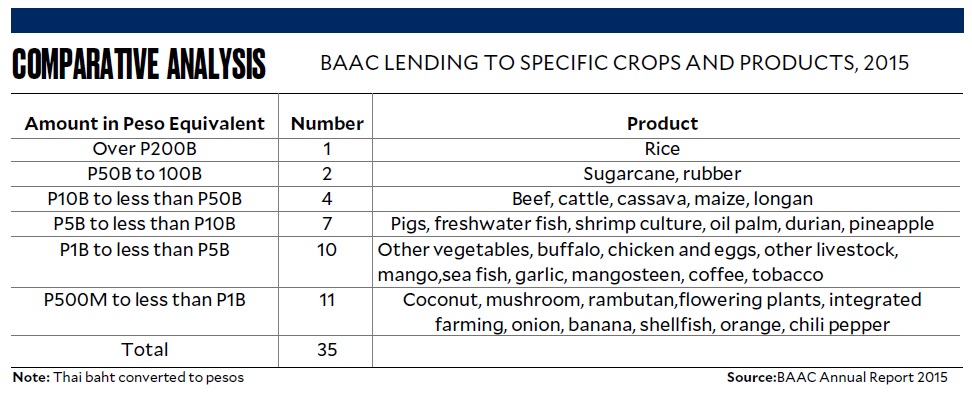Comparing Thai Agri bank and Land Bank
(Second of two parts)
The Bank of Agriculture and Agriculture Cooperative (BAAC) lent to at least 35 specific agri-aqua industries, with lending of P1 billion or more to 15 crops, five livestock and poultry, and three for aquaculture and fishing. Of the 23 products, 13 are export-oriented.
LBP had no detailed breakdown, but there were three categories: small farmers and fishers (P38.7 billion), agri-aqua businesses (P46.1 billion), and LGUs (local government units) and GOCCs (government-owned and controlled corporations) borrowings to support agri-aqua projects (P52.8 billion). There appears to be disproportionate share of lending to LGUs and GOCCs for total agri-aqua lending at 53:47 in its favor. Lending to farmers and agribusiness amounted to P84.8 billion.
Can LBP scale up its agri lending?
The new LBP president targets to triple agri lending to about P500 billion by 2022. This would be at the level BAAC lent in 2015, if it includes lending to GOCCs. If excluded, the targeted lending would be P254 billion in 2022 or half of BAAC’s today.
There are several challenges to expanding LBP agri lending:
First, the average land holding in the Philippines is only 1.3 hectares (2012 Census) versus 3.6 ha for Thailand (2013 Census). The scenario requires farm consolidation for economies of scale and mechanization. Many of the small holders are agrarian reform beneficiaries that are also amortizing their lands to LBP. Only 17 percent of ARBs reportedly pay land amortization.
Second, it is difficult to package projects in the Philippines due to low farm productivity. This LGU-based extension service needs revamp after 25 years of “experimentation.”
Third, most farm production are small and scattered and not diversified, and this discourages investors in agri processing and, in turn, export.
Fourth, the quality of rural infrastructure needs a hard look. The Philippines is an archipelago while Thailand is one land mass with excellent road network.
Fifth, the land ceiling of 5 ha is a major disincentive to corporate nucleus estates and even small and medium private investors. Small investors indicate around 20 ha scale to cover overhead and profits. The irony is that there are large areas of under-utilized private and public lands.
A Mindanao agri-businessman claimed: At the very root of the problem is the higher cost of production. This increases risk in the part of both the investing farmer and the “coinvesting” lender. If the government properly addresses the cost issues then risking funds can be justified by the higher spreads. One of these cost issues is security costs as well as extortion by the insurgents.
Are there solutions to these multi-lemma? Yes. Inject more management systems to the countryside. Are there working Asian models? Yes.
In Malaysia, the Federal Land Consolidation and Rehabilitation Authority (Felcra) began as a program in 1966 and by 1996, it operated 1,781 projects on 250,000 ha and 117,530 smallholders.
Land consolidation is not new. Taiwan pioneered a radical one in the 1970s, and in 2009: small farms, large tenants or lessors. Vietnam is promoting small plots, large fields. In Ilocos Norte, Philippines, the Piddig Multipurpose Cooperative found success by increasing farm yield and doubling small farmers’ incomes.
Farm consolidation facilitated farm mechanization and irrigation schedules, lowered inputs costs, and enhanced marketing power.
LBP president Alex Buenaventura has proposed the corporative scheme. Following the business models of the Federal Land Consolidation and Rehabilitation Authority and the Federal Land Development Authority (Malaysia), the corporative will hire professional managers to run the projects. The ultimate beneficiaries will be the small farmers who will earn dividends from the estates and processing plants as well as wages. This is a game changer. The models have been in place since the 1970s and a key driver in the dramatic reduction of rural poverty in Malaysia.
Expanding agri lending is not just funds-driven. Sound lending practice must assess markets, product standards, technology, financial health and managerial capacity of borrowers. Thailand has a base of competitive and highly diversified agriculture aquaculture and agri-manufacturing. The Philippines has a limited one. This is the scenario that the country faces.
But the greater challenge for LBP is that it is a universal bank and draws deposits from the private sector. It is subject to Bangko Sentral supervision and Basel III banking standards.

Agri lending is a crucial element to grow agriculture, increase farm incomes and reduce rural poverty. The scale of lending is important as well as risk mitigation such as crop insurance and disaster relief. And then the investment environment such as access to land for less or to own.
Three options have come up with respect to LBP.
First, retain the profitable LBP as a universal bank subject to BSP and Basel III metrics. This means maintaining nonagri/agra lending.
Second, restructure LBP. Former DA Secretary Senen Bacani has long advocated a gradual phase out of private deposits in order to take out the fiduciary responsibility of LBP to private depositors. At the same time, nonagri/agra and non-LGU lending can be phased out so that LBP can focus on its original mandate.
Under this scheme, the national government can then use the bank as an instrument in implementing desired policies especially on credit. LBP to be sustainable without government subsidy still has to at least breakeven. Hopefully, additional credit losses due to its reaching out to underserved sectors will not offset the substantial profit it is making today.
Third, the government financial institutions can allocate half of their annual profits to a new entity called the Agribusiness Fund. The Fund can lend and cost-share to agri projects under professional management, particularly for those inclusive agribusiness.
These are among the options that the government should seriously study to spur agribusiness investments and inclusive growth in the countryside.
With a rural poverty incidence of 30 percent in 2015, twice the Asean peers average, the Philippine policy makers and implementations have a long way to go.
